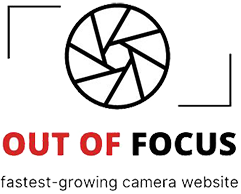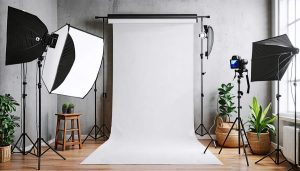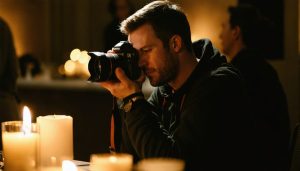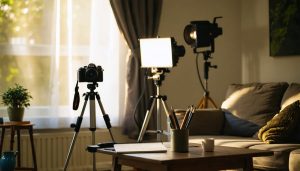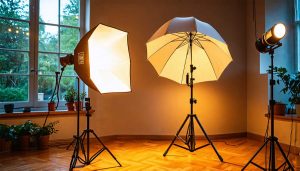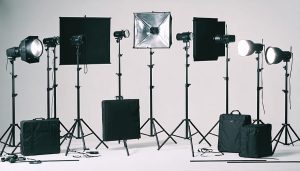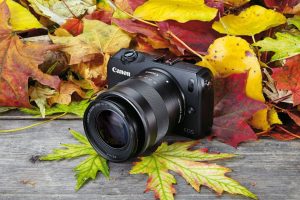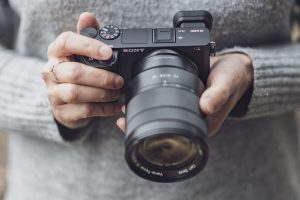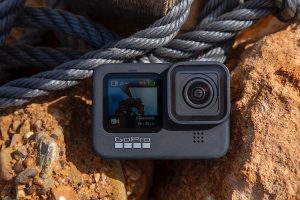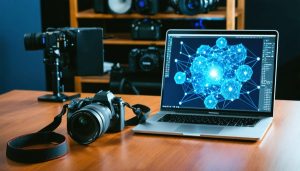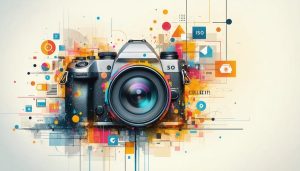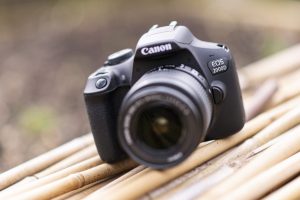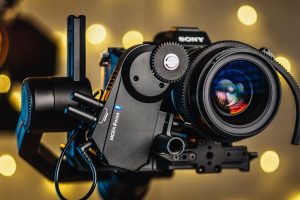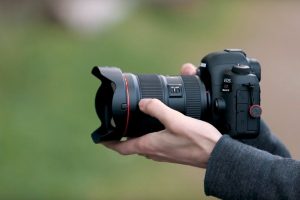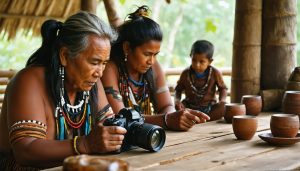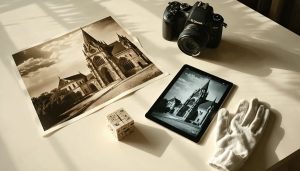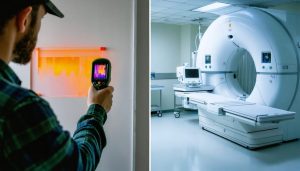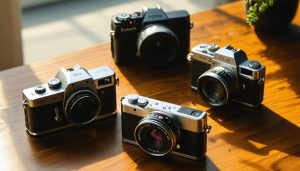
Transform your studio lighting into an eco-friendly powerhouse while maintaining professional-quality results and reducing your carbon footprint. LED technology has revolutionized sustainable photography, offering up to 80% energy savings compared to traditional tungsten lighting without compromising output quality or color accuracy.
Smart lighting design isn’t just about switching to energy-efficient bulbs—it’s about creating an integrated system that maximizes natural light, minimizes waste, and adapts to your shooting needs. Modern LED panels and strips provide precise control over color temperature and intensity while consuming a fraction of the power, lasting up to 50,000 hours, and generating minimal heat.
The shift toward sustainable lighting solutions represents a crucial step in reducing photography’s environmental impact. By combining energy-efficient fixtures with thoughtful studio design, photographers can significantly decrease their energy consumption while potentially saving thousands in operating costs annually. From daylight-balanced LEDs to solar-powered options and smart control systems, today’s eco-friendly lighting solutions offer unprecedented flexibility and environmental responsibility without sacrificing creative control.
This comprehensive guide will explore cutting-edge sustainable lighting techniques, helping you build a more environmentally conscious studio while enhancing your photographic capabilities.
LED Lighting: The Sustainable Photographer’s Best Friend
Power Efficiency vs Traditional Studio Lights
When comparing modern LED lighting solutions with traditional studio lights, the differences in power efficiency are striking. If you’re new to studio lighting basics, understanding these differences can help you make more sustainable choices from the start.
Traditional tungsten and fluorescent studio lights typically consume between 500-2000 watts per unit, while equivalent LED lights use just 100-300 watts to produce the same light output. To put this in perspective, a typical photo shoot using three traditional 1000W lights would consume 3000 watts per hour. The same setup with LED alternatives might only use 600-900 watts total.
This efficiency translates directly to your electricity bills. For a busy studio operating 40 hours per week, switching from traditional to LED lighting can reduce energy consumption by up to 80%. Over a year, this could mean savings of several thousand dollars while significantly reducing your carbon footprint.
LEDs also generate much less heat, requiring less air conditioning in your studio space. This creates a cascading effect of energy savings beyond just the lights themselves. While the initial investment in LED lighting might be higher, the combination of lower energy costs, reduced cooling needs, and longer bulb life makes them the clear winner for both environmental and financial sustainability.
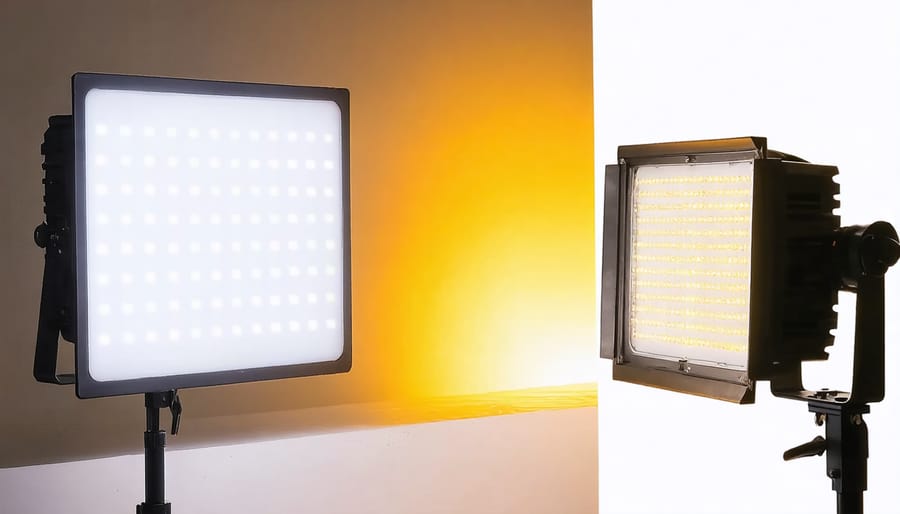
Color Accuracy and Temperature Control
Modern LED lighting systems have revolutionized color accuracy in photography while maintaining eco-friendly credentials. High-quality LEDs can achieve a Color Rendering Index (CRI) of 95+ and above, ensuring colors appear natural and true-to-life in your shots. This level of accuracy was once exclusively associated with traditional tungsten lights, but LEDs now match or exceed this performance while consuming significantly less energy.
Temperature control has also seen remarkable advancement in LED technology. Many contemporary LED panels offer adjustable color temperature ranges from 2700K to 6500K, allowing photographers to seamlessly transition from warm, intimate indoor lighting to crisp daylight conditions. This flexibility eliminates the need for multiple specialized fixtures or color correction gels, reducing both material waste and energy consumption.
What’s particularly impressive is how these systems maintain consistent color accuracy throughout their dimming range. Unlike older lighting technologies that shift color temperature when dimmed, quality LED lights maintain their selected color temperature from 100% down to 1% brightness. This precision not only ensures better results but also reduces the need for post-processing adjustments and the associated computer energy usage.
Some advanced LED systems even offer RGB color mixing capabilities, providing endless creative possibilities without requiring additional filters or accessories that would eventually end up in landfills. The durability of these systems, often rated for 50,000+ hours of use, further reinforces their environmental benefits through reduced replacement needs.
Natural Light Optimization Techniques

Studio Layout and Window Positioning
The key to maximizing natural light in your studio starts with thoughtful positioning of your workspace. Position your main shooting area near large windows, ideally those facing north or south to avoid harsh direct sunlight while still capturing abundant ambient light. This setup is fundamental to successful natural light photography techniques and reduces reliance on artificial lighting.
Consider installing adjustable window treatments like translucent curtains or blinds to control light intensity and direction. White or light-colored walls help bounce and diffuse natural light throughout the space, creating a more even illumination. If possible, arrange your workspace so that computer screens and monitors face away from windows to minimize glare and maintain accurate color perception.
For maximum efficiency, create distinct zones within your studio: a primary shooting area near windows, a post-processing station in a controlled-light environment, and a client consultation area that benefits from natural light without interfering with shoots. Keep your workspace flexible with movable furniture and portable reflectors, allowing you to adapt to changing light conditions throughout the day.
Remember to account for seasonal light changes when planning your layout. What works perfectly in summer might need adjustment during winter months when daylight is limited.
Reflective Materials and Diffusers
Natural light manipulation doesn’t always require energy-consuming solutions. Reflective materials and diffusers offer eco-friendly alternatives that harness and shape available light effectively. White foam boards, for instance, serve as excellent reflectors and are both affordable and recyclable. These versatile tools bounce light into shadow areas, creating balanced illumination without additional power consumption.
Fabric-based diffusers, made from sustainable materials like organic cotton or recycled polyester, soften harsh natural light while maintaining its quality. These materials are durable, washable, and have a minimal environmental footprint. For a DIY approach, repurposed white bed sheets or frosted shower curtains can work surprisingly well as diffusion materials.
Metallic reflectors, when properly maintained, can last for decades. Look for options made from recycled aluminum or sustainable materials. These reflectors are particularly effective for outdoor shoots, providing powerful light control without requiring any power source.
Consider installing adjustable reflective panels in your studio space. These permanent fixtures can be positioned to maximize natural light throughout the day, reducing the need for artificial lighting. When selecting materials, opt for those with high reflectivity ratings but minimal environmental impact during production and disposal.
Smart Lighting Controls and Automation
Motion Sensors and Timers
One of the most effective ways to reduce energy waste in your photography studio is through automated lighting controls. Motion sensors and timers act as vigilant assistants, ensuring lights are only active when needed. By installing occupancy sensors in less frequently used areas like storage rooms or corridors, you can automatically turn off lights when no movement is detected for a set period, typically 5-15 minutes.
Smart timers offer another layer of automation by scheduling your lighting system around your actual working hours. For instance, you can program your main studio lights to switch on 15 minutes before your first shoot and power down after your last session. Many modern systems even allow remote control through smartphone apps, letting you adjust settings on the go or respond to schedule changes.
These automated solutions are particularly valuable for larger studios with multiple rooms or those operating with varying schedules. A properly configured system can reduce lighting-related energy consumption by 50-75%. Consider installing dual-technology sensors that combine both motion and ambient light detection – these ensure lights don’t activate unnecessarily during daylight hours when natural light is sufficient.
For optimal results, position sensors strategically to cover entry points and high-traffic areas while avoiding false triggers from outside movement or reflective surfaces. Remember to adjust sensitivity settings based on your studio’s specific layout and usage patterns.
Mobile Apps and Remote Management
Today’s photography studios are embracing smart lighting solutions that put complete control at your fingertips. Mobile apps have revolutionized how we manage our studio lighting, offering unprecedented convenience and energy efficiency.
Most modern LED lighting systems now come with dedicated apps that transform your smartphone into a powerful control center. These apps allow you to adjust brightness, color temperature, and even create custom lighting presets from anywhere in your studio – or even remotely when you’re away. This means you can power down unused lights without running around the studio, and schedule automatic shutoffs to prevent wasted energy.
Many apps also provide detailed energy consumption metrics, helping you track and optimize your studio’s power usage. You can identify peak usage times, monitor individual fixture performance, and make data-driven decisions about your lighting setup. Some systems even integrate with smart home platforms, allowing you to coordinate your studio lighting with other building systems for maximum efficiency.
For multi-room studios, these apps are particularly valuable. You can create zones, manage multiple setups simultaneously, and ensure lights aren’t accidentally left on in unused areas. The ability to control everything from a single interface not only saves time but also helps reduce your studio’s carbon footprint through more precise energy management.
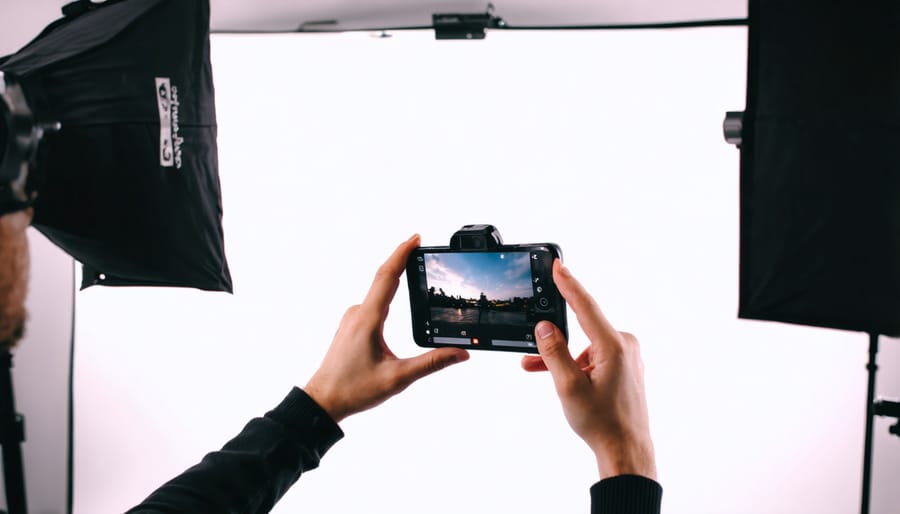
Sustainable Lighting Accessories
Recycled and Biodegradable Materials
As photographers become more environmentally conscious, the market for sustainable lighting modifiers and accessories has grown significantly. Many manufacturers now offer eco-friendly alternatives to traditional lighting gear, using recycled and biodegradable materials that reduce our environmental footprint without compromising quality.
Recycled plastic diffusers and reflectors are becoming increasingly popular, often made from post-consumer materials that would otherwise end up in landfills. These products maintain the same optical properties as their conventional counterparts while giving plastic waste a second life. Some innovative brands have even developed biodegradable softboxes using bamboo frames and organic fabric diffusion material.
Light stands and grip equipment are also getting the eco-treatment, with manufacturers utilizing recycled aluminum and sustainable bamboo components. These materials not only reduce environmental impact but often provide additional benefits like improved durability and lighter weight.
For DIY enthusiasts, repurposed materials can create effective lighting solutions. Old bed sheets can become diffusion panels, while cardboard shipping boxes can be transformed into flags and gobos. These creative alternatives not only save money but also keep materials out of the waste stream.
When shopping for lighting accessories, look for products with minimal packaging made from recycled materials. Many manufacturers now use biodegradable packaging solutions and soy-based inks for printing. Remember that choosing durable, high-quality products that last longer ultimately creates less waste than frequently replacing cheaper, less sustainable options.
Long-lasting Equipment Choices
When it comes to sustainable lighting, durability is just as important as energy efficiency. Investing in long-lasting equipment not only reduces waste but also proves more cost-effective in the long run. LED panels and strobe lights from reputable manufacturers like Profoto, Godox, and Broncolor are built to withstand years of professional use, often lasting 50,000 hours or more before showing any significant degradation.
Consider modular lighting systems that allow for component replacement rather than complete unit disposal. For instance, many professional LED panels feature replaceable diffusion panels and power supplies, extending their useful life significantly. Look for fixtures with robust housing materials like aluminum or high-grade polymers, which resist damage and maintain optimal heat dissipation.
Maintenance plays a crucial role in equipment longevity. Regular cleaning of light modifiers, proper storage in padded cases, and careful handling during setup and breakdown can double or triple the lifespan of your gear. When selecting light stands and mounting hardware, opt for quality materials like aircraft-grade aluminum or carbon fiber – they may cost more initially but will outlast cheaper alternatives many times over.
Don’t overlook the importance of proper cables and connectors. High-quality power cables with strain relief and gold-plated connectors resist wear and maintain consistent performance. Many photographers find success with braided cables that resist tangling and physical stress, reducing the need for frequent replacements.
Remember, the most sustainable choice is often the one you won’t need to replace for many years to come.
As we’ve explored throughout this guide, transitioning to eco-friendly lighting doesn’t mean compromising on quality or creativity. By implementing LED lighting systems, maximizing natural light, and adopting energy-efficient practices, photographers can significantly reduce their environmental impact while maintaining professional standards.
Start your sustainable lighting journey by conducting an energy audit of your current setup. Replace traditional hot lights with LED alternatives gradually, focusing first on your most frequently used equipment. Consider investing in light modifiers that help maximize output while minimizing power consumption.
Remember that small changes add up. Installing motion sensors, using power strips to prevent phantom energy drain, and scheduling regular maintenance of your equipment all contribute to a greener studio. Don’t forget to properly dispose of or recycle old equipment through certified recycling programs.
For outdoor shoots, make the most of natural light by planning around golden and blue hours. When working indoors, position your workspace to capitalize on available daylight, supplementing with artificial lighting only when necessary.
The photography industry’s future lies in sustainable practices. By embracing eco-friendly lighting solutions today, you’re not just reducing your carbon footprint – you’re also future-proofing your business and potentially reducing operational costs. Take the first step by implementing one or two of these suggestions, then gradually expand your sustainable practices as you become more comfortable with the changes.
Remember, every watt saved counts toward a more sustainable future for photography.
